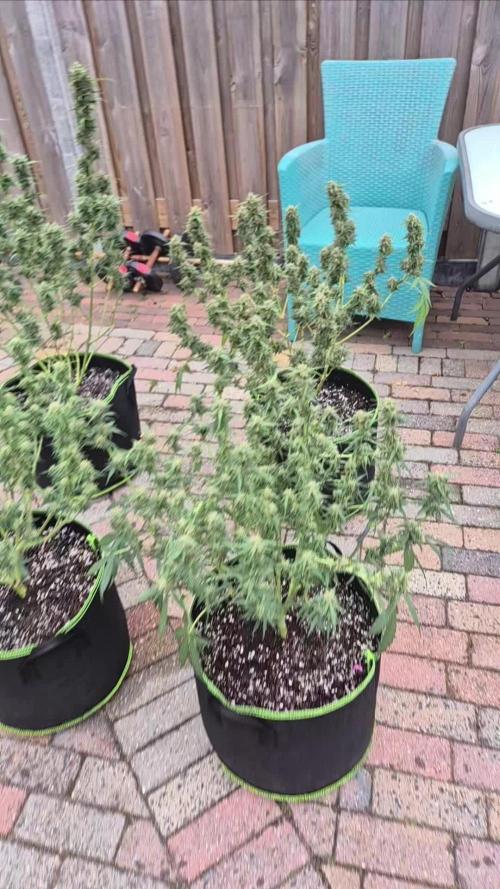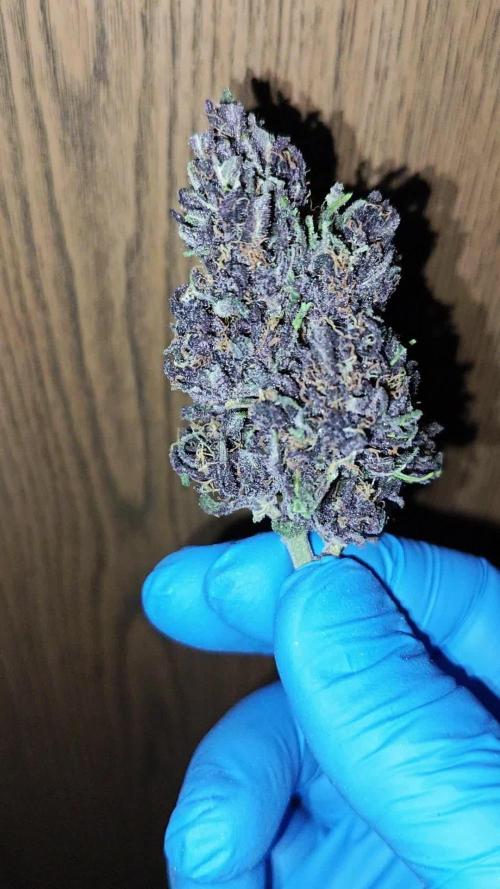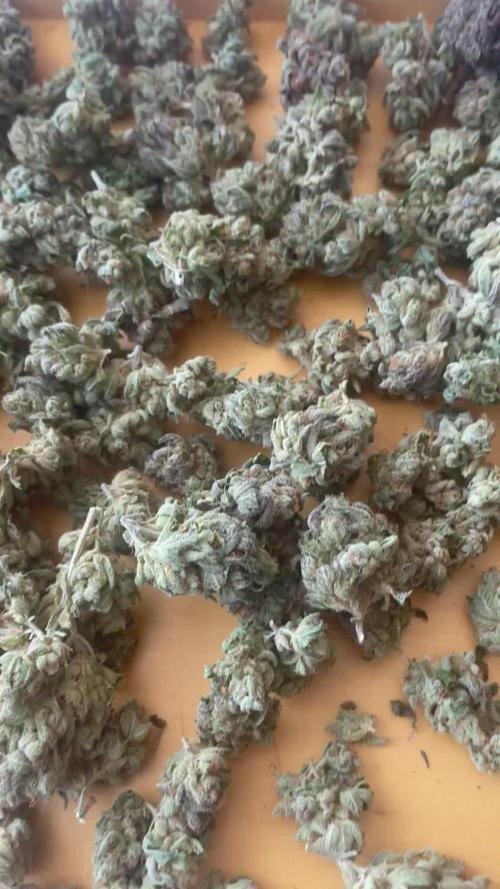The Grow Awards 2026 🏆 































Likes
Comments
Share


@Barzenegger
Follow
I've turned down the lights again to 60%, and with the increased feeding last week, the GMO and Glookies really seem to be getting back some green where it was almost gone. The overdose in N from CalMag Agent seemed to have done the trick. Some of the lower leaves on the Glookies are already quite dark green, and since I expect to harvest (some) in 2-5 weeks, I don't want to overfeed it now. So I have reduced the CalMag Agent level again.
Sour Strawberry and Acapulco Gold are unimpressed and continue to slowly fade.
They have also gained a bunch of weight again, all in all it's going ok now.
Likes
2
Share


@Meisenberg
Follow
Buds stacking up nicely. Did some overdue trimming/defoliation to help with light and airflow. They are some thirsty girls. Looks like I've got all 3 phenotypes of this strain represented: short and bushy, thin and wispy, and Original Recipe. I'm not sure which is which. Meh. I'm optimistic regardless.
Likes
7
Share


@STAYINGONMYMAINCBATORUNTWO
Follow
Smoke report! 10/10/20
Tastes like heaven 😍 the beauty tastes like pure joy lemon dessert 🍨 sweet and mellow vanilla honey cream flavours! Has pink tones and a beautiful look on the nug! She’s a beauty makes you feel it instantly every hit is to the head! Put you into deep thought great feelings dreamy almost 😅
Can’t believe I got 12g off a solo! Was grown in a 300ml pot! Dried for 5 days in brown paper bags at 52%rh 18c (64.4f) very strong pungent lemon flavour and smell and that’s before cure so be so much more stronger in 2-4weeks! Can’t wait to grow her properly in a 10-15L pot
Likes
Comments
Share


@mihixd
Follow
D64
4 days since last watering and lower leaves were drooping, max 3 days between waterings
20L with nutrients
D67
20L with nutrients
added bamboo support for heavy nugs
D70
20L with nutrients
Likes
1
Share


@DmbTexasRanger
Follow
I should’ve scrog’ed with my strongest two plants.
Trying to pull some very heady buds so went all out on Advsnced Nutrients. Going to A/b test with budget synthetics next grow
Likes
16
Share


@Lazuli
Follow
started with lockout but then the weed fairy came by and the plant produced major colas lmao
Likes
57
Share


@DeepWaterGrower
Follow
🗓️ WEEK 8 / DAY 50-56
⚡ Light: 30 cm / 150 watt;
⌛ Schedule: 18/6;
🌡️ 24.5° C - 65% RH average;
📑 PH 6.1 - EC 2.3;
🌱 Phenotype #1 is forming beautiful flowers, for two weeks I have been rotating the plants 180° every 3 days, so as to make the buds that would receive less light also swell. Height: 48 cm;
🌱 Phenotype #2 just stopped stretching and begins the flowering stage. Height: 55 cm;
⚙️ Fan, extractor and pump ON 24/0.
👯♀️ As you can see in the pics, I have other seedlings in my grow-box, here the diaries if you want to take a look:
- White Widow (GHS): https://growdiaries.com/diaries/198827-green-house-seed-co-white-widow-grow-journal-by-deepwatergrower
- Opium (Divine seeds): https://growdiaries.com/diaries/206602-divine-seeds-opium-grow-journal-by-deepwatergrower
Processing
Likes
66
Share


@Teamdirtbag3
Follow
This update is dedicated to @greenmachine.
Slurricane blast with Butane.
Dimonds and sauce.
Is there anything more to say?
It came out BEAUTIFUL. 🔥💎🔥💎🔥💎😁
Likes
11
Share


@TgOgFaRms
Follow
week 5 flowering - No herms, strong aroma, and THC production! 🌿🌸🌱🔥
Hello, fellow growers! It's time for another thrilling update on my flourishing journey. We've officially entered week 5 of the flowering phase, and things are looking absolutely fantastic. Here's what's been happening in my grow room:
The most exciting news is that I haven't encountered any hermaphroditic plants thus far. It's a relief to see the ladies staying true to their gender and focusing solely on bud development. 🚫⚡️
The aroma emanating from the grow room is simply amazing! The fragrance has become more pronounced and enticing, filling the space with the delightful scent of resinous goodness. It's a testament to the terpene profiles of these strains. 🌿👃🌸
Additionally, the THC production is in full swing! The buds are swelling and becoming denser by the day. It's truly a sight to behold, and I can't wait to see how they'll develop further as we progress through the flowering stage. 🌿🌱🌸💪
While the plants are thriving, I've noticed a slight nutrient burn on the tips of some leaves. To address this, I've decided to dial back the nutrient concentration a bit for this week. It's important to maintain a careful balance and avoid overfeeding, especially during this critical phase. 💧💚
As for the nutrient solution, the pH has remained stable at 6.33, ensuring optimal nutrient uptake by the plants. The TDS (Total Dissolved Solids) level has been consistently maintained between 1150 and 1250, providing the plants with the necessary nutrient balance. ⚖️📈
With everything going so well, I'm filled with excitement for the upcoming week of flowering. Let's continue to nurture these beautiful plants and enjoy the bountiful rewards they will bring. Happy growing, lads! 🌿💚🌸😎
Processing
Likes
10
Share


@mkrmkr
Follow
Completing the seventeenth week.
Plant 1 - Completing the seventeenth week of life.
Plant 2 - Completing the sixteenth week of life.
Plant 3 - Completing the sixteenth week of life.
KeepGrowing.......!
Likes
7
Share


@Gingobeaz
Follow
Und Ende!
75 Tage nach Einsetzen in die Erde ich die Banana Purple Punch fertig.
Die Terpene riechen sehr lecker. Wahnsinnig viel Ertrag kann ich nicht erwarten, um im Legalen Rahmen zu bleiben wirds trotzdem etwas zu viel sein. Insgesamt ein sehr schöner Strain den ich definitiv wieder anbauen würde!
Auch die Greenhouse Feeding Bio line hat mich absolut überzeugt.
Den nächsten Indoor grow werde ich allerdings auf Kokoserde mit Athena Pro line starten. Seid gespannt 🏼
______________________________________
And the end!
75 days after planting in the ground, the Banana Purple Punch is ready.
The terpenes smell very delicious. I can't expect an insanely high yield, but it will still be a bit too much to stay within the legal limits. All in all, a very nice strain that I would definitely grow again!
The Greenhouse Feeding Bio line has also absolutely convinced me.
However, I will start my next indoor grow on coco soil with Athena Pro line. Stay tuned 🏼
🍌💜🥊
Likes
136
Share


@Qutro
Follow
Ran 2 seed from both, all popped easy. Veg stage was smooth—Candy Store RBX with medium long internal soacing, Marshmallow OG compact and sturdy. Topped, LST’d, ScrOG’d, both responded like champs.
Flowering hit week 4: Candy Store kept those fluffy buds, sweet berry/candy smell blasting. Marshmallow stretched like crazy until week 4. Had to lift the Candy to keep the canopy even. Marshmallow OG went full compact, colas dense, straight gassy with a heavy chemical punch— diesel vibes in the mix. Trichomes frosted early, looked insane by week 6.
Harvest week 9: Candy Store RBX gave frosty, a bit fluffy buds, pure candy/berry flavor, uplifting and social. Marshmallow OG delivered tight, dense nugs, straight gas, chemical-heavy flavor, relaxing body buzz creeping in. Both fire, but totally different vibes. Candy = fruit bomb, Marshmallow = full on gassy chem punch.
Visually and flavor-wise, the two perfectly complement each other. I’m super happy with this round. Both turned out purple at the end of flowering.👌
Processing
Likes
15
Share


@eldruida_lamota
Follow
Que hay familia, volvemos con las crazy cookies, que variedad más locura no veas que puntones se han formado , variedad algo lenta en cuanto a floración pero valdrá la pena .
Ph controlado temperatura también dentro de los parámetros , humedad baja, menos de 45%.
Pronto aportamos overdrive y veremos cómo terminan de hinchar.
Likes
20
Share


@TheGourmetWeed
Follow
Hey guys!
So, finally Saturday I chopped her down. She looked now ready and delicious, although I only notice yesterday how many seeds she has allover the place. She hermied in front of me without noticing, not good at all and need to start looking much better and in detail into the plants.
Feel like an idiot now.
Anyways, it was a full week!
Emptied the grinder collector and pressed it down a little, makes a very nice smoke, light but pleasant, the kind of stuff it keep you going all day without the dumb effect.
From all trimming made the bubble hash. Got a little too green as the 220micron bag's stitches slightly opened letting some contaminants in the final mix, hence the green color.
This was a hit. in opposition to the grinder stuff, this sent me straight to the moon, really heavy stone effect, even thinking was hard. Reminded me those afghan/ moroccan balls we used to get back in the early 2000's.
The weed itself it's still drying so the smoke report will be updated in there.
715g of fresh cut plant is good, let's see the potency and the seeds. Might turn it all into bubble hash, if I see it'll be an hassle to remove seeds.
On an earlier bud I've cut and dried, smoked it and you can see pure white ashes in the bong. Ain't that a beauty?
Likes
16
Share


@eldruida_lamota
Follow
Vamos, última semana de floración de las Blueberry Cheese de ZambezaSeeds.
Octava semana y es que están ya explotadas y maduras estas flores, ya llevan 7 días solo agua y con u. Respectivo lavado de raíces , ya están preparadas para afilar tijeras.
Tienen un progreso bastante rápido con 8 semanas voy a poder cosechar que no está nada mal.
Gracias a los productos de Agrobeta tendré buenos resultados.
Agrobeta:
https://www.agrobeta.com/agrobetatiendaonline/36-abonos-canamo
Mars hydro:
Code discount: EL420
https://www.mars-hydro.com/
Las maximas de temperatura no superan los 26 grados y las mínimas no bajan 20, así que no me puedo quejar.
Los niveles de humedad también son los correctos van entre 45%/55% de humedad relativa.
Por supuesto el Ph lo estamos dejando alrededor de 6.
Hasta aquí es todo, buenos humos 💨💨💨.
Likes
78
Share


@ClubRiot
Follow
Week 7 ,
pH Perfect Connoisseur Bloom Part A ( 1 ml/L )
pH Perfect Connoisseur Bloom Part B ( 1 ml/L )
CarboLoad Liquid ( 2 ml/L )
Sensi Cal-Mag Xtra ( 2 ml/L )
Sensizym ( 2 ml/L )
Bio-Heaven ( 2 ml/L )
Big Bud ( 2 ml/L)
Nirvana (2 ml/L)


























